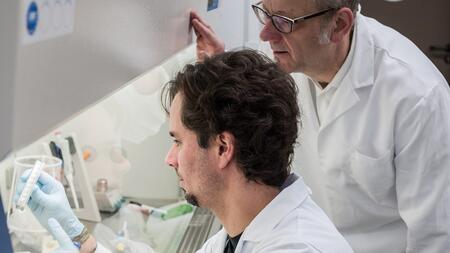New treatment approach for tuberculosis discovered
In the light of growing antibiotic resistance, developing alternative tuberculosis treatment approaches is of critical importance. Scientists at the Research Center Borstel and the DZIF have now shown that the spread of the tuberculosis pathogen Mycobacterium tuberculosis can be curbed by specific reinforcement of the human immune system. The results have been published in the journal Cell Host & Microbe.
Tuberculosis is amongst the top most dangerous infectious diseases for humans. According to the WHO, 10.4 million people worldwide contracted tuberculosis in 2016 alone, and 1.7 million died of complications related to the infection. Particularly the emergence of multidrug-resistant variants of the tuberculosis pathogen Mycobacterium tuberculosis, constitute a major global healthcare challenge. Patients infected with this pathogen can no longer be treated with conventional antibiotics, resulting in considerable increases in duration of treatment, more severe side effects and growing death rates. Cases of tuberculosis infection with entirely resistant pathogens have already been described, and were consequently classified as more or less non-treatable. This situation underlines that alternative treatment approaches are urgently needed in addition to new antibiotics. A currently promising approach is host-directed therapy. Here, a patient’s immune system is specifically influenced so as to mitigate potential tissue damage and deterioration of symptoms whilst curbing the bacteria’s spread and reproduction.
In the Cellular Microbiology research group at the Research Center Borstel, a team led by Dr Tobias Dallenga and Prof Ulrich E. Schaible has now been able to show that certain human immune cells, so-called neutrophil granulocytes constitute a promising target for host-directed therapy. Neutrophil granulocytes play a central role in the disease development and represent the predominant lung cell population affected by Mycobacterium tuberculosis during active infection. Tuberculosis pathogens cause rapid inflammatory death of the infected cells using the same method as granulocytes do: granulocytes usually form oxygen radicals, which they direct at pathogens in order to kill them. Mycobacterium tuberculosis manipulates granulocytes in such a way that they direct the oxygen radicals at themselves and consequently die of necrotic cell death. The neutrophil granulocytes’ death results in a release of tuberculosis pathogens and, if these are ingested by macrophages together with the dead granulocyte, they grow in the host cells subsequently also killing these. This initiates a vicious cycle, including cell death, attraction of further host cells and bacterial growth which lead to destruction of lung tissue and coughing of infectious droplets. The team from Borstel has now been able to show that inhibiting cell death of infected granulocytes by supressing oxygen radical formation helps the host cells control the pathogen’s growth and hence interrupt the vicious cycle.
The researchers are convinced that these results create a base for novel host-directed therapy. “We aim to contain the resulting tissue damage and consequently remove tuberculosis pathogen’s base for growth,” says Prof Ulrich Schaible. “This treatment approach could already be in close proximity as drugs that control granulocytes are already on the market and could find a new application in the treatment of tuberculosis.”




